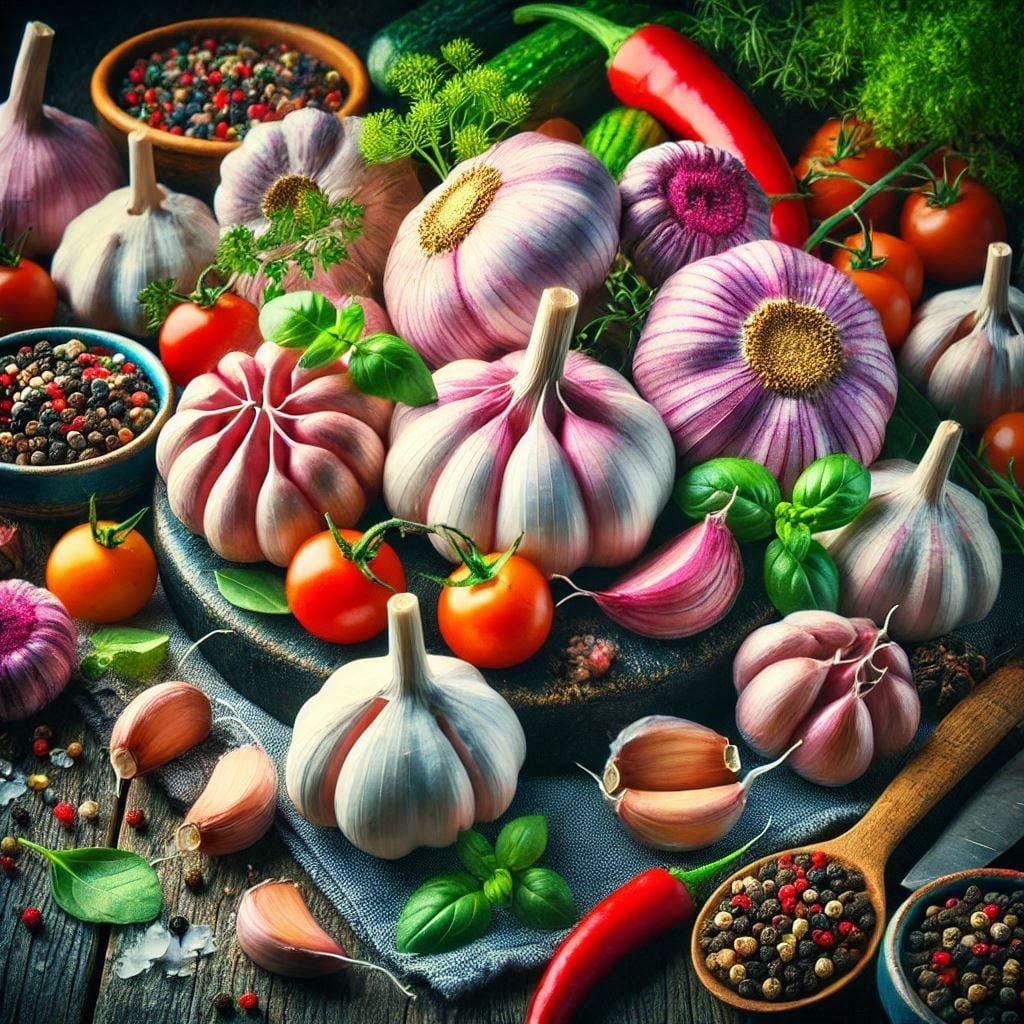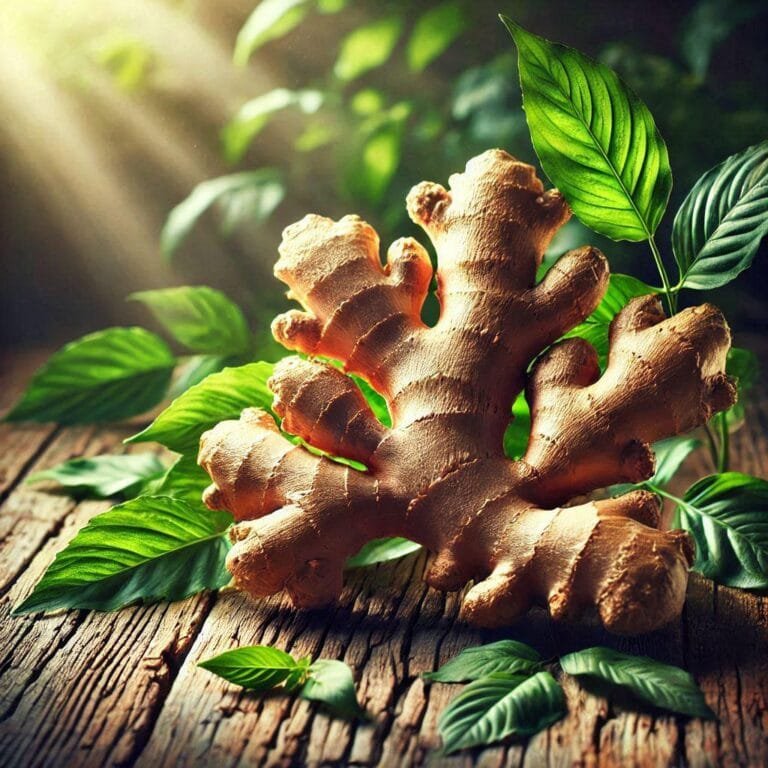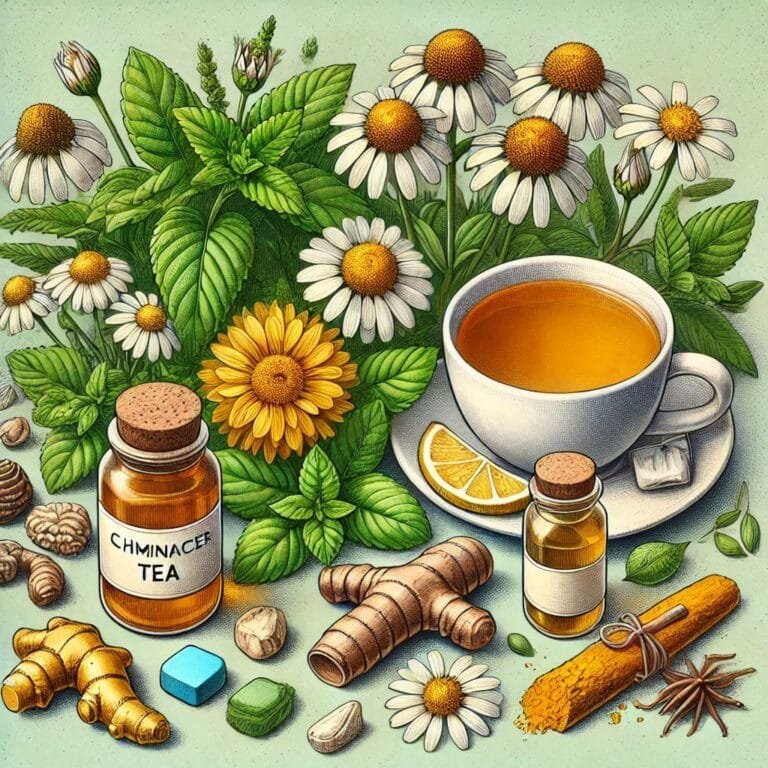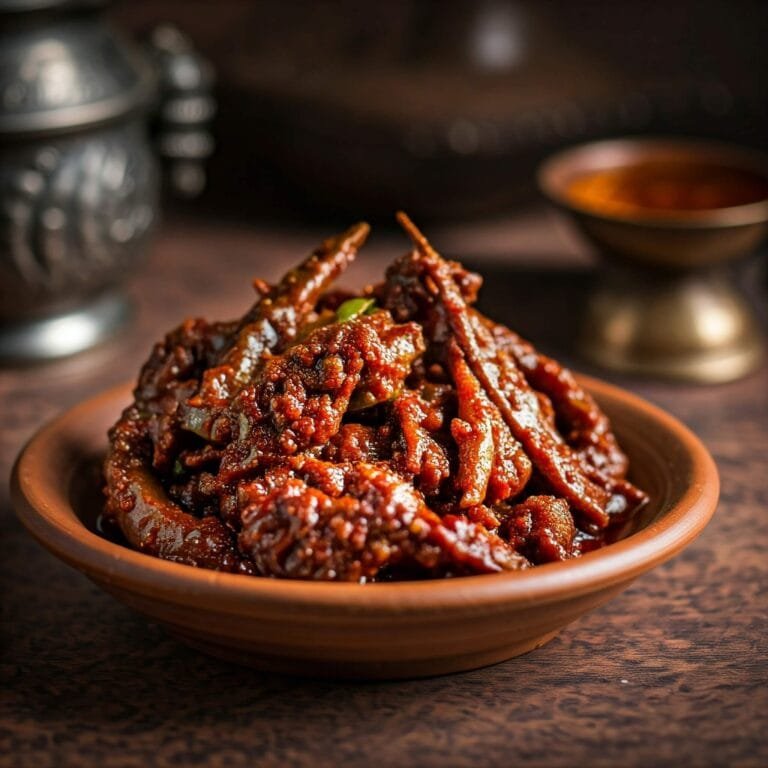The Mighty Garlic: A Culinary and Health Wonder

Introduction
Garlic, a member of the Allium family, has held significant importance in various cultures worldwide, celebrated not only for its culinary prowess but also for its myriad health benefits. Historically, this potent ingredient has been revered in different societies, where it found its place in both kitchens and traditional medicine cabinets. Its distinctive flavor and aroma have made garlic an essential component in a multitude of dishes, from savory stews to flavorful sauces, enhancing the eating experience across diverse cuisines.
Beyond its culinary applications, garlic’s medicinal properties have been acknowledged for centuries. Ancient civilizations, including the Egyptians, Greeks, and Romans, utilized garlic as a remedy to treat a plethora of ailments, showcasing its longstanding reputation as a health ally. Modern research has corroborated many of these historical claims, revealing that garlic contains a wealth of bioactive compounds, such as allicin, which are believed to contribute to its therapeutic effects. These properties include potential benefits such as heart health support, antimicrobial effects, and antioxidant protection, making garlic a subject of interest for both health professionals and nutritional enthusiasts alike.
As we delve deeper into the captivating world of garlic, this blog post will explore its rich history, culinary versatility, and a wide array of health benefits. From tips on selecting and storing garlic to innovative recipes that highlight its unique qualities, we aim to provide a comprehensive understanding of why this humble bulb is regarded as a culinary and health wonder. Garlic is not just a flavor enhancer; it serves as a cultural symbol and a testament to the interconnection between food and well-being throughout human history.
The History of Garlic
Garlic (Allium sativum), a member of the onion family, has a rich history that dates back thousands of years. Its origins can be traced to Central Asia, where it was first cultivated around 6,000 years ago. Ancient Egyptians held garlic in high esteem, often associating it with strength and vigor. Workers who built the Great Pyramids were provided with garlic in their diet, believed to enhance stamina and fortify health. Evidence of garlic’s extensive use in Egypt can also be found in hieroglyphics and burial sites, indicating its sacred status.
Beyond Egypt, garlic was also prevalent in ancient Greece and Rome. Greek physician Hippocrates, often referred to as the ‘Father of Medicine’, prescribed garlic for various ailments, including respiratory issues and fatigue. Roman soldiers consumed garlic before battle, believing it would serve as a powerful talisman against injury. As a result, garlic became a staple in their diet, showcasing its importance not only as a flavor enhancer but also for its purported health benefits.
In addition to the Mediterranean region, garlic made its way to Asia where it became a vital component in Chinese cuisine and medicine. Traditional Chinese medicine regards garlic as a versatile remedy for ailments such as colds and digestive issues. Over the centuries, it has been included in numerous health rituals and dietary practices across various cultures, solidifying its reputation as both a food and a medicine.
As garlic spread throughout the world, it garnered a celebrated position in different culinary traditions. From Italian pasta dishes to Indian curries, its robust flavor and health properties have made garlic an indispensable ingredient. Today, garlic continues to be revered not only for its culinary versatility but also for its myriad of health benefits, further embellishing its historical significance.
Garlic in Different Cultures
Garlic, a bulbous plant belonging to the Allium family, has been cherished for its flavor and health benefits across various cultures throughout history. Notably, in Mediterranean cuisine, garlic plays a paramount role, often serving as a base for sauces such as aioli and pestos. In Italy, dishes like spaghetti aglio e olio highlight how garlic enhances simple ingredients, showcasing its ability to elevate the culinary experience. The infusion of garlic into olive oil results in a fragrant oil utilized for drizzling or dipping, illustrating the plant’s versatility.
In Asian cultures, garlic holds a significant status too. For instance, in Chinese cooking, garlic is frequently used to impart depth to stir-fries, marinades, and sauces. Its pungent flavor is critical in dishes such as Kung Pao chicken, exemplifying its integral role in enhancing umami profiles. Moreover, in Korean cuisine, garlic is often fermented or included in sauces, such as gochujang, contributing robust flavors essential to traditional meals.
Beyond its culinary applications, garlic is steeped in folklore and cultural beliefs. In many Slavic communities, garlic is traditionally viewed as a protective agent against evil spirits and misfortune, prompting its incorporation into various rituals. In contrast, African cultures have historically utilized garlic not only for its flavor but also for its potential medicinal properties, engaging in practices that emphasize its utilization in holistic healing. This perception emphasizes the multifaceted significance of garlic, extending its value beyond the plate.
From the Mediterranean to Asia, and across various ethnic backgrounds, garlic represents more than just an ingredient; it embodies traditions, cultural identity, and communal bonds. Its profound impact on culinary practices and its revered status in numerous cultures affirm garlic’s role as a truly global culinary and health wonder.
Historical Medicinal Uses
Garlic has a storied history that dates back thousands of years, serving not only as a culinary ingredient but also as a powerful medicinal item. Ancient civilizations recognized the therapeutic properties of garlic, utilizing it in various forms to treat a range of ailments. The Sumerians, around 3000 BC, referred to garlic in their medicinal texts, indicating its importance in early healing practices. It was used for its antibacterial and antifungal properties, primarily due to the presence of allicin, a compound that forms when garlic is crushed or chopped.
In ancient Egypt, garlic was valued for boosting strength and endurance; it was reportedly given to laborers working on the pyramids to enhance their stamina. Additionally, garlic was associated with various health benefits and was used to treat headaches, digestive disorders, and respiratory ailments. Historical texts, including those from Hippocrates, illustrate garlic’s use in healing. Hippocrates himself prescribed garlic for several health issues, from infections to digestive problems, reflecting its widespread acceptance in ancient Greek medicine.
Moreover, in traditional Chinese medicine, garlic has been utilized since antiquity for its warming effects on the body and its ability to ward off infections. Various cultures across Asia and Europe adopted garlic for its purported benefits, and over time, these practices helped shape modern herbalism. In contemporary times, the legacy of ancient healers continues to influence our understanding of herbal remedies, as garlic remains prominent in both folk medicine and scientific studies aimed at exploring its potential health benefits.
As we trace the evolution of garlic’s medicinal uses, we see a remarkable journey from ancient remedies to modern herbal practices, exemplifying the enduring nature of this powerful bulb in promoting health and wellness.
Health Benefits of Garlic
Garlic, a staple in many kitchens around the world, is not only cherished for its distinctive flavor but also revered for its remarkable health benefits. Rich in essential nutrients, garlic contains various vitamins and minerals, including vitamin C, B6, manganese, and selenium. Moreover, it is packed with powerful compounds such as allicin, which is believed to be responsible for many of garlic’s health-promoting effects.
One of garlic’s most prominent health advantages is its positive impact on the immune system. Consuming garlic regularly may help in improving immune response, making individuals less susceptible to common illnesses, such as colds and flu. The presence of antioxidants in garlic also plays a crucial role in combating oxidative stress, promoting overall well-being by protecting cells from damage.
In addition to boosting immunity, garlic is particularly beneficial for heart health. Studies have shown that it can help lower blood pressure, reduce cholesterol levels, and improve overall circulation. These properties are believed to stem from the ability of garlic to promote vasodilation, which enhances blood flow and reduces strain on the cardiovascular system. Consequently, garlic consumption is often recommended as part of a heart-healthy diet.
Furthermore, garlic exhibits notable anti-inflammatory properties that can aid in reducing chronic inflammation, which is linked to various health conditions, including heart disease and diabetes. The sulfur compounds in garlic are thought to help modulate the body’s inflammatory response, contributing to greater overall health.
In conclusion, garlic is a powerful ally for those looking to enhance their health. Its well-documented immune-boosting, heart-protective, and anti-inflammatory benefits make it a valuable addition to any diet. By incorporating garlic into meals, individuals can enjoy its culinary delights while reaping its vast health rewards.
Culinary Uses of Garlic
Garlic, a fundamental ingredient across diverse culinary traditions, has earned its place as a staple in kitchens around the globe. Known for its distinct flavor and aroma, garlic not only enhances the taste of dishes but also offers numerous health benefits. In Mediterranean cuisine, for instance, garlic is a predominant element, utilized in dishes such as aioli, a creamy garlic dip, and the classic skordalia, a garlic and potato spread. The rich flavor profile that garlic provides elevates the freshness of salads, marinades, and roasted vegetables, making it an indispensable component of Mediterranean gastronomy.
In Asian cuisines, particularly in Chinese cooking, garlic is often used in stir-fries, sauces, and soups, where it contributes a robust flavor that balances sweeter and spicier notes. Dishes such as kung pao chicken and garlic fried rice showcase garlic’s versatility, as it acts to amplify the overall flavor experience without overpowering other ingredients. Similarly, in Indian cuisine, garlic is a key ingredient in various masalas, lending depth to curries and enhancing the aromatic quality of traditional dishes like butter chicken and dal.
Latin American cuisine reflects a heavy reliance on garlic as well, with its use in salsas, marinades, and stews. The popular dish, mojo, is a garlic-based sauce that adds a punch to grilled meats or seafood, showcasing garlic’s flexibility and ability to complement a range of proteins. Furthermore, in the world of Italian cooking, garlic is quintessential in both pasta dishes and sauces, such as the beloved garlic and olive oil spaghetti, known as aglio e olio. Its ability to seamlessly blend with other ingredients underscores garlic’s crucial role in global culinary practices.
Growing Garlic: Tips and Techniques
Growing garlic can be a rewarding venture for any gardener, whether a novice or an expert. The first step in cultivating this aromatic bulb is choosing the right type of garlic. There are primarily two categories: hardneck and softneck. Hardneck garlic tends to have a richer flavor and produces a flower stalk, while softneck garlic is easier to braid and store. Depending on the local climate, the selection between these types can greatly influence the yield and quality of the crop.
When it comes to planting garlic, timing is crucial. Ideally, garlic should be planted in the fall, about 4 to 6 weeks before the ground freezes. This timing allows the roots to establish before winter. Garlic prefers well-draining soil enriched with organic matter, so preparing the bed with compost can significantly enhance growth. The cloves should be planted upright, with the pointed end facing the sky, at a depth of about 2 inches. Spacing them approximately 6 inches apart will provide adequate room for the bulbs to grow without overcrowding.
Harvesting garlic is typically done in mid to late summer when the lower leaves begin to brown. At this stage, the bulbs have matured but have not yet split. It is vital to handle the bulbs carefully to avoid damage. After harvesting, garlic should be cured in a dry, well-ventilated area. Curing is essential for extending the storage life of garlic, allowing the outer skin to harden properly.
Managing pests and diseases is crucial for a healthy garlic crop. Common pests include aphids and nematodes, while diseases such as white rot can affect the roots. Implementing crop rotation, maintaining optimal soil conditions, and utilizing organic pest control methods can help mitigate these challenges. By following these tips and techniques, gardeners can enjoy a bountiful harvest of garlic, reaping both culinary and health benefits.
Fun Facts About Garlic
Garlic, scientifically known as Allium sativum, has captivated cultures across the globe for centuries. This bulbous plant is not only a staple in culinary practices but also steeped in intriguing folklore and trivia. For instance, many ancient civilizations believed garlic possessed protective properties. In ancient Egypt, garlic was so revered that it was included in the diet of pyramid builders, who thought it would enhance their strength and endurance. This historical reverence laid the groundwork for its fame as a “superfood.”
Another interesting fact is garlic’s association with superstition. Throughout history, garlic has been cited as a deterrent against evil spirits and vampires. This belief is especially popular in various European cultures, where it was common to hang garlic cloves in doorways or wear them around the neck as a talisman of protection. Alongside its reputation as a protective agent, garlic was also thought to ward off the plague during the Middle Ages; in a time of fear, it became a symbol of hope and resilience.
Moreover, garlic’s health benefits have been recognized since ancient times. The Greek physician Hippocrates frequently recommended garlic to aid digestion and improve overall wellness. Despite the passage of time, modern science continues to unveil the health-promoting compounds within garlic, such as allicin, which is noted for its potential antibacterial and anti-inflammatory properties. Interestingly, there are over 600 varieties of garlic worldwide, with each type offering distinct flavors and qualities, making it a versatile ingredient in countless cuisines.
While garlic is often celebrated for its culinary uses and health benefits, its rich tapestry of myths and cultural significances will continue to make garlic a fascinating topic for exploration and discussion.
Conclusion
To summarize, garlic has established itself as more than just a staple ingredient in numerous culinary traditions around the world; its myriad health benefits further enhance its significance. This versatile bulb has been celebrated not only for its distinct flavor but also for its potential to contribute positively to overall well-being. From its antioxidant properties to its role in supporting cardiovascular health, garlic offers a unique combination of culinary enjoyment and health advantages.
The discussions throughout this blog post illustrated that incorporating garlic into your daily diet can be both easy and rewarding. Whether it is used in marinades, soups, or roasted alongside vegetables, garlic lends itself to a variety of dishes while promoting health. For those cautious about strong flavors, garlic can also be introduced gradually, allowing individuals to find their preferred balance without sacrificing taste or nutritional benefits.
As you consider the immense potential of garlic, we encourage you to explore different methods of including this powerful ingredient in your meals. The potential health benefits are compelling enough to make garlic a regular feature in your culinary repertoire. Furthermore, by subscribing to the ZestBites channel, you can unlock a wealth of culinary insights and recipes that enhance your cooking experience. Our community is dedicated to encouraging healthy eating while celebrating the joy of food, so join us in discovering the many ways garlic can elevate your dishes and well-being. Embrace the mighty garlic as part of your daily life and reap the rewards it has to offer.






